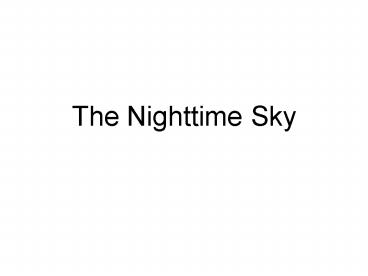The Nighttime Sky - PowerPoint PPT Presentation
1 / 39
Title:
The Nighttime Sky
Description:
Today, constellations are well-defined regions on the sky, irrespective of the ... The constellations that the Sun passes in front of are known as the zodiac ... – PowerPoint PPT presentation
Number of Views:258
Avg rating:3.0/5.0
Title: The Nighttime Sky
1
The Nighttime Sky
2
Visible stars on a clear night
- Unaided human eye 6,000 stars
- At any one time 3,000 stars
- ½ above horizon, ½ below horizon
- Reality light pollution and other factors limit
visible stars to a few hundred - Suburban 500
- Inner-city 300
3
Constellations
0
In ancient times, constellations only referred to
the brightest stars that appeared to form groups,
representing mythological figures.
4
(No Transcript)
5
Orion, the Hunter
Leo, the Lion
Scorpius, the Scorpion
Cygnus, the Swan
Antlia, the Air Pump
6
0
Today, constellations are well-defined regions on
the sky, irrespective of the presence or absence
of bright stars in those regions.
7
(No Transcript)
8
Constellation names are derived from the myths
and legends of antiquity.
Belt of Orion
9
Looking at the Sky
- Constellations
- 88 official constellations
- Many origins
- Greeks, Southern European cultures, Middle East,
Asia, etc. - Traced back as far as 5,000 years ago
- Stars define the celestial sphere
10
Constellations
- Constellations are patterns of stars that the eye
picks out. The stars are usually not near each
other they just lie in the same direction.
11
The stars of a constellation only appear to be
close to one another Usually, this is only a
projection effect. The stars of a constellation
may be located at very different distances from
us.
0
12
Orion
0
Betelgeuze
Rigel
Stars are named by a greek letter (a, b, g)
according to their relative brightness within a
given constellation the possessive form of the
name of the constellation Betelgeuze a
Orionis, Rigel b Orionis
13
Observing Focus Ursa Major (Big Bear, Big
Dipper)
14
Finding stars Polaris, Arcturus, Spica using big
dipper
Take arc to Arcturus
Then spike Spica
Pole Star (Polaris)
15
Winter constellations
16
Real motion in the solar system
- Earth is spinning (rotating)
- Earth is orbiting (revolving around) the Sun
- The Moon is orbiting Earth
- The other planets are also orbiting the Sun
17
Paths of Stars
- Earths counter-clockwise rotation
- Stars rise in the East, set in the West
- But some stars never set!
- Polaris stays nearly stationary in the sky
- Stars near Polaris move slightly, in circular,
counterclockwise paths - Some objects are never visible from the north
- Magellanic clouds (SH)
- Star positions change from night to night as the
Earth revolves about the Sun rise and set 4
minutes earlier each day.
18
Risings and Settings
- The spin of the earth causes the stars to
appear to rotate about the celestial pole. Some
stars are therefore circumpolar and never set,
while others dip below the horizon. Which stars
are which depend on where you are on earth. - Polaris happens to be very near the North
celestial pole.
19
Apparent motion Earths rotation
- Imagine standing at the North Pole
- The North Star is straight overhead
- All of the stars move in big circles along the
horizon - Stars never rise and never set!
20
Rotation of CS
NCP
Star
Celestial equator
Earth
Celestial sphere
SCP
21
(No Transcript)
22
Apparent Motion
0
23
Circumpolar Stars
24
Circumpolar Stars
25
Circumpolar Stars - SH
26
Apparent motion Earths rotation
- Imagine standing at the equator
- The North Star is on the horizon
- All of the stars rise in the East, pass straight
overhead, and set in the West
27
What you see depends upon where you are
NCP
Star
Horizon for observer at north pole
np
Earth
28
The Night Sky at the Equator North South
Celestial Poles are on the horizon
North Celestial Pole (North Star)
29
Equator
30
Most of us are in between these extremes we see
fixed Polaris (N. Celestial Pole star) over the
night, stars move WESTWARD about it
Looking North
E
W
31
Mid-latitudes
32
Apparent Motion
0
33
Diurnal Motion
- Each day, the earth rotates once (west-to-east)
on its axis. This causes us to face different
directions and see different stars. The stars
daily (diurnal) motion reflects the earths spin.
34
The Yearly Motion
In addition to rotating, the Earth also revolves
about the Sun.
As the earth revolves the Sun is projected in
front of different constellations at different
times of year. The path the Sun takes across
heavens is called the ecliptic. The
constellations which the Sun passes through are
zodiac constellations.
Because the Sun is bright, we can only see some
constellations at certain times of year.
35
(No Transcript)
36
Apparent motion Earths rotation
- The celestial sphere appears to rotate once every
24 hours - Polaris (the North Star) is very close to the
North Celestial Pole - Everything appears to move in circles around the
North Star
37
(No Transcript)
38
Apparent motion Earths orbitSeasonal stars
constellations
- To see the stars at night, you must look away
from the Sun - As Earth moves in its orbit, the stars you can
see at night keep changing - Constellations and stars are seasonal
39
Apparent motion Earths orbitThe apparent
motion of the Sun
- The Sun is always in front of some stars
- As Earth moves in its orbit, the Suns apparent
position in the sky changes - The constellations that the Sun passes in front
of are known as the zodiac

